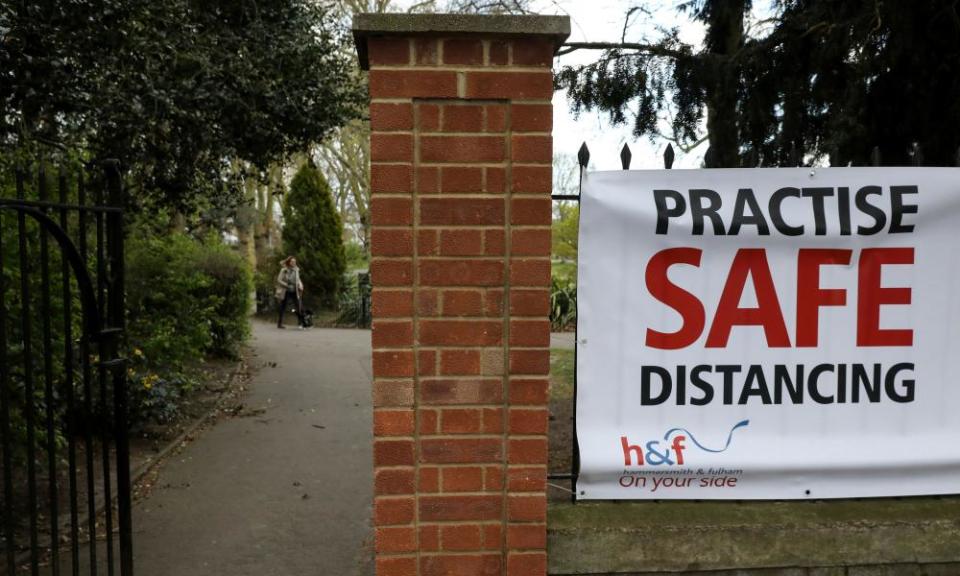It took lockdown to finally make me feel at home in London

I spent a lot of last year walking to and from hospital. On the way, I would pass an unprepossessing patch of grass, optimistically referred to as the local park, and consider how fantastically bleak it was that for our neighbourhood, this – this – constituted a public space.
I’d contrast it with sprawling, endless Hyde Park, my favourite spot in London, aside from when it’s commandeered by irresponsible fringe lunatics holding their toxic rallies (Michael Bublé’s British Summer Time concert, 2018).
This place, in comparison, was limp and joyless, with sad, bare little trees, a scrap of lawn and a squat hut in one corner that turned out on closer inspection to be a sewage pumping station – a northerner’s idea of what a London green space is like.
In the past few months, which I have spent largely trapped in one room, the park has begun to resemble the garden of Eden.
Away from the vast, unimaginable tragedies and the small, stinging necessities of the real pandemic, there are the quirks of lockdown. And while our experiences are all different, they are not very different – that is one of the quirks.
The great revelation for me has been the way that our worlds have become atomised, and how they have shrunk. For those of us still working, the fragmentation of office life has removed all sorts of mental barriers. Everything suddenly seems more manageable and less intimidating. I am forever talking one-on-one, with no one to overhear, and everyone’s lives on partial display; apologising for the washing machine in the background, or breaking off to ask a child to shut up. The glorious anarchy of real life has breached the po-faced masquerade of the corporate world. We are all Prof Robert Kelly now.
The shrinking has been interesting too – and ironic. For the first time since I came to London, I know my neighbours. And now I know them, I can’t go within two metres of them. Or within three fridges of them, if we’re using the new national system of measurement.
The wallpaper of my life has been pulled down, so I have had to hang a new one. I sit by the window to work, and I have got used to the rhythms of other people’s lives in a way that usually only happens when you’re close to someone. There’s the woman across the street who stands outside smoking and, when she sees someone she knows, illuminates from within like a plastic snowman. There’s the teenager who takes his football for a walk every afternoon, the straps of his mask cutting into his towering bouffant; the pregnant lady in the gargantuan ice-white trainers; the bloke with the motorbike and the Queen hoodie. I am so grateful for this pantomime of familiarity that I’m not even going to be rude about Queen. During the weekly clap for frontline workers, we would all smile quietly at one another. Life resembles a wholesome Rear Window.
Other film homages have been less enjoyable to live through. I don’t dare venture as far as Hyde Park because the walk to get there is too busy. I went once, on the last day before lockdown, and Kensington High Street possessed the chilled out ambience and heartening community spirit of Dawn of the Dead.
My favourite escape routes, then – a large, cherished park, the intensity of live music – are out of bounds. But just as strangers have stepped unknowingly into the void left by friendly faces, so the small familiar area around my house has risen to its challenge. Not just the sun-baked streets of early summer, but the red brick and blue plaques, the houses that tumble down the road from the terracotta tube station, and that small neighbourhood green space I used to malign.
I took a notebook there to finish this piece. Walking anywhere now is slightly stressful: I’m an absolutist about social distancing, so spend most of the journey in the road. That was intimidating even before Michael Gove suggested that anyone worried about their eyesight should immediately drive a car.
Outside the park there is one world – PRACTISE SAFE DISTANCING, screams a banner strapped to the railings – and inside there is another, as the leaves at the entrance, turned half-spectral by the sun, reach down to lift you away. The grass is burnt, worn and bare already, but with a beauty of its own, and around the walls, penned in by houses, are untold gradations of green. In the middle-distance, the trees look shaggy and stoned.
The park is made of irregular, impractical shapes, fenced off from one another by low, black railings, for which there must be some invisible reason. Now I love its imperfections like you love a person’s imperfections, its limitations and flaws. There is a misshapen stone slab in the middle of the grass, and a hole where there was once a tree. The day before, I was almost decapitated there by a Frisbee.
Someone has chalked EID MUBARAK on the concrete. Further along there are rainbows and the outlines of dancing people. Amid all the hurt there is some measure of happiness.
As our worlds have shrunk, my park has grown, and I have grown to love it.
• Rick Burin is a writer from the north of England

 Yahoo News
Yahoo News 